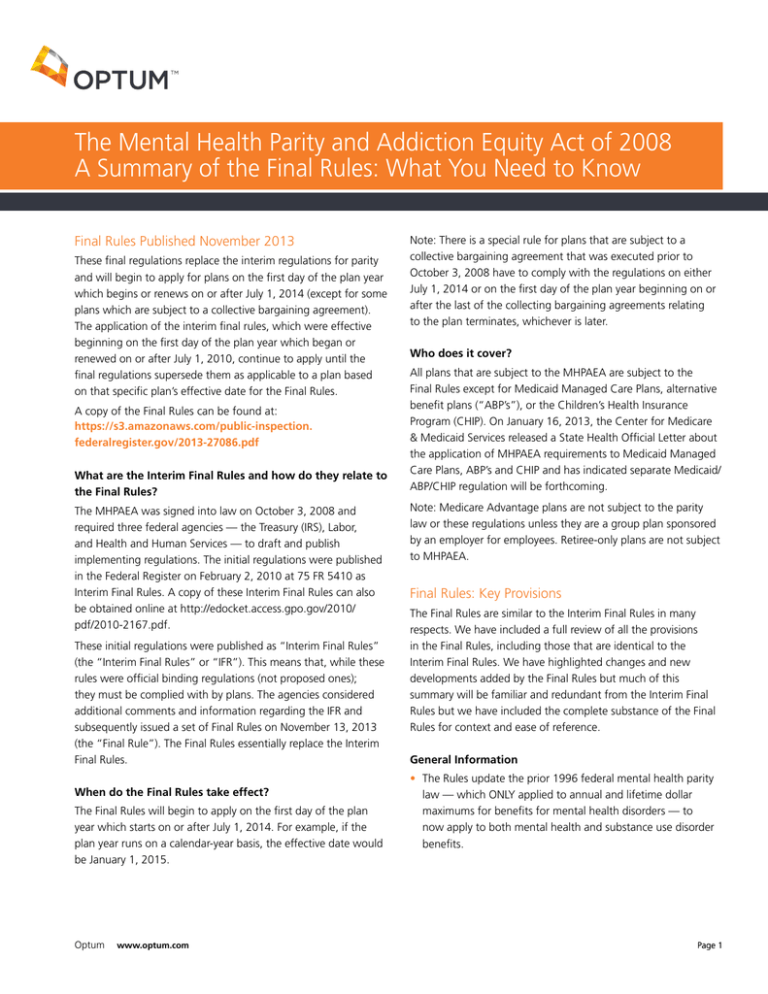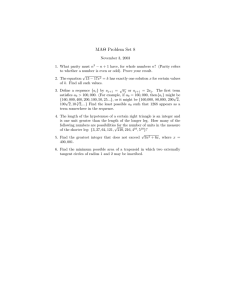
The Mental Health Parity and Addiction Equity Act of 2008
A Summary of the Final Rules: What You Need to Know
Final Rules Published November 2013
These final regulations replace the interim regulations for parity
and will begin to apply for plans on the first day of the plan year
which begins or renews on or after July 1, 2014 (except for some
plans which are subject to a collective bargaining agreement).
The application of the interim final rules, which were effective
beginning on the first day of the plan year which began or
renewed on or after July 1, 2010, continue to apply until the
final regulations supersede them as applicable to a plan based
on that specific plan’s effective date for the Final Rules.
A copy of the Final Rules can be found at:
https://s3.amazonaws.com/public-inspection.
federalregister.gov/2013-27086.pdf
What are the Interim Final Rules and how do they relate to
the Final Rules?
The MHPAEA was signed into law on October 3, 2008 and
required three federal agencies — the Treasury (IRS), Labor,
and Health and Human Services — to draft and publish
implementing regulations. The initial regulations were published
in the Federal Register on February 2, 2010 at 75 FR 5410 as
Interim Final Rules. A copy of these Interim Final Rules can also
be obtained online at http://edocket.access.gpo.gov/2010/
pdf/2010-2167.pdf.
These initial regulations were published as “Interim Final Rules”
(the “Interim Final Rules” or “IFR”). This means that, while these
rules were official binding regulations (not proposed ones);
they must be complied with by plans. The agencies considered
additional comments and information regarding the IFR and
subsequently issued a set of Final Rules on November 13, 2013
(the “Final Rule”). The Final Rules essentially replace the Interim
Final Rules.
When do the Final Rules take effect?
The Final Rules will begin to apply on the first day of the plan
year which starts on or after July 1, 2014. For example, if the
plan year runs on a calendar-year basis, the effective date would
be January 1, 2015.
Optum
www.optum.com Note: There is a special rule for plans that are subject to a
collective bargaining agreement that was executed prior to
October 3, 2008 have to comply with the regulations on either
July 1, 2014 or on the first day of the plan year beginning on or
after the last of the collecting bargaining agreements relating
to the plan terminates, whichever is later.
Who does it cover?
All plans that are subject to the MHPAEA are subject to the
Final Rules except for Medicaid Managed Care Plans, alternative
benefit plans (“ABP’s”), or the Children’s Health Insurance
Program (CHIP). On January 16, 2013, the Center for Medicare
& Medicaid Services released a State Health Official Letter about
the application of MHPAEA requirements to Medicaid Managed
Care Plans, ABP’s and CHIP and has indicated separate Medicaid/
ABP/CHIP regulation will be forthcoming.
Note: Medicare Advantage plans are not subject to the parity
law or these regulations unless they are a group plan sponsored
by an employer for employees. Retiree-only plans are not subject
to MHPAEA.
Final Rules: Key Provisions
The Final Rules are similar to the Interim Final Rules in many
respects. We have included a full review of all the provisions
in the Final Rules, including those that are identical to the
Interim Final Rules. We have highlighted changes and new
developments added by the Final Rules but much of this
summary will be familiar and redundant from the Interim Final
Rules but we have included the complete substance of the Final
Rules for context and ease of reference.
General Information
• T he Rules update the prior 1996 federal mental health parity
law — which ONLY applied to annual and lifetime dollar
maximums for benefits for mental health disorders — to
now apply to both mental health and substance use disorder
benefits.
Page 1
The Mental Health Parity and Addiction Equity Act of 2008 • T he Rules do not mandate coverage of any mental health and
substance use disorder benefits. However, if a plan chooses
to provide coverage for mental health and substance use
disorder benefits, it must do so in compliance with the Rules.
Plans may define which conditions they will cover and which
they will not; however, fully insured plans are also subject to
state law mandates and both fully insured and self-insured
plans may be subject to mandates under the Affordable Care
Act which include coverage of mental health and substance
use disorder treatment benefits.
• T he Rules add some additional terms and clarify the meaning
of existing terms contained in the law. We will discuss these
terms in the context of the various provisions of the Rules in
the following sections.
Parity Regulations for Financial Requirements
and Treatment Limitations
General Requirement
• A
s stated in the MHPAEA, plans must ensure that the financial
requirements and treatment limitations applied to mental
health and substance use disorder benefits are no more
restrictive than those applied to medical/surgical benefits. The
Rules amplify and explain the basis for determining this parity.
Key Terms
• Q
uantitative Treatment Limitations: Benefit plan limits
which are expressed in terms of a numeric amount that serves
to limit the scope or duration of the benefits such as day
limits, visit limits, limits on length of treatment or episodes
of treatment.
• N
on-Quantitative Treatment Limitations: Benefit plan
limits that are not numeric but serve to limit the scope
or duration of treatment such as medical management
strategies, network admission standards, reimbursement
methodologies.
• “ Classification” of benefits: The Rules establish six
classifications of benefits:
– Inpatient, in-network (IIN)
– Inpatient, out-of-network (ION)
– Outpatient, in-network (OIN)*
– Outpatient, out-of-network (OON)*
– Prescription drugs
–Emergency
Parity must be determined on a classification-by-classification
basis. This means parity is assessed for each requirement or
Optum www.optum.com
limitation between medical/surgical benefits and mental
health and substance use disorder benefits of the same
classification. If a plan offers medical benefits in one
classification, it must also provide mental health and
substance use disorder benefits in that classification as
well, assuming the plan has chosen to provide coverage for
mental health and substance use disorder benefits.
• “ Type” of financial requirements and treatment
limitations: This refers to a requirement or limitation of
the same nature (e.g., copayments or annual day limits are
different “types” of requirements/limitations).
• “ Level” of requirements/limitations: The magnitude of a
single type of requirement. For example, different levels of
copayments (e.g., $10 and $25) within a single classification
of benefits.
• “ Coverage Unit”: The groupings of individuals covered by
the plan (e.g., individual, individual-plus-spouse, family).
Because requirements and limitations may vary by coverage
unit, the Rules specify that general parity be assessed
separately for separate coverage units.
Financial Requirements and Quantitative
Treatment Limitations
The Rules clarify how to apply the general parity requirement to
financial requirements (copayments, coinsurance, deductibles)
and quantitative treatment limitations (e.g., day limits, visit limits,
number of episode limits, etc.) by means of a specific calculation
method.
FINAL RULES UPDATE
For purposes of applying the financial requirement and
treatment limitation rules:
The rules reiterate the earlier safe-harbor guidance issued
on July 1, 2010, that permits dividing the outpatient
classifications into two subdivisions for (i) office visits and
(ii) all other outpatient items and services in order to
calculate parity of financial requirements and quantitative
treatment limitations.
The law now accommodates testing multi-tier plans, such
as one which includes out-of-network, in-network, and
premier network benefits. It works by dividing the in-network
tier into sub-classifications that reflect the in-network
benefits and premier network benefits. The in-network
sub-classifications must be created in compliance with the
nonquantitative treatment limitation rules.
Page 2
The Mental Health Parity and Addiction Equity Act of 2008 The method is as follows:
1.Determine whether a type of requirement or treatment
limitation applies to “substantially all” medical/surgical
benefits — meaning two-thirds or more of the medical/
surgical benefits within the specific classification (or subclassification) of benefits. “Substantially all” is based on the
dollar amount of plan payments for benefits as determined
by any reasonable method of the plan’s choosing.
2.If a type of financial requirement or treatment limitation does
not apply to “substantially all” medical/surgical benefits in a
classification (or sub-classification) of benefits, it cannot be
applied to mental health or substance use disorder benefits in
that classification (or sub-classification).
Example: If, for the outpatient, in-network office subclassification, less than two-thirds of the benefits are subject
to a copayment, then a copayment cannot be applied to
the outpatient, in-network office-based mental health and
substance abuse benefits.
3.If a single level of a type of requirement or limitation applies
to more than half of the benefits in a classification (or subclassification), then that is also considered the “predominant”
requirement or limitation, which must be applied to officebased mental health and substance use disorder benefits in
the same classification (or sub-classification).
Example: If the medical/surgical benefits have only one level
of copayment for all outpatient, in-network office-based
services (say, $20), then that is the “predominant” requirement
and the outpatient, in-network copayment for mental health
and substance use disorder services cannot be more restrictive
than that “predominant” copayment (so the mental health
and substance use disorder copayment would need to be,
in this case, $20 or less).
4.If there is more than one level of a type of a requirement or
limitation, then further analysis must be done to determine
which of the various levels is the “predominant” level. The
“predominant” level is the one which applies to more than
half of all the benefits (again based on cost as noted under
No. 1 above), which are subject to that type of requirement/
limitation.
Example: A plan’s medical/surgical benefits provide two
levels of copayments for outpatient, in-network office-based
benefits: primary care at $20 and specialty care at $30. Upon
analysis, the plan assesses that the $20 copayment applies
to more than half of the total plan payments for these
benefits (and is considered the “predominant” copayment).
Optum
www.optum.com
Therefore, the copayment for outpatient, in-network
office-based mental health and substance use disorder
benefits must be $20 or less.
If no single level is considered to be “predominant,” then
the Rules discuss combining levels until more than half of
the benefits are subject to the requirement, and then the
least restrictive level of those used to reach that threshold is
considered the “predominant” level.
5.If a plan provides benefits for more than one coverage unit
and applies different levels of a requirement/limitation based
on coverage unit, then the “predominant” level is determined
separately for each coverage unit.
In regards to benefits for prescription drugs, the Rules allow
these benefits to be tiered based on “reasonable” factors
(including cost, efficacy, generic vs. brand-name, and mail-order
vs. pick-up). Parity is to be assessed separately based on
these tiers.
Cumulative Financial Requirements and
Cumulative Treatment Limitations
The Rules define “cumulative financial requirements” and
“cumulative treatment limitations” as ones that apply across
covered expenses/treatments and which determine whether,
and to what extent, benefits are provided. The most common
examples are deductibles, out-of-pocket maximum limits, and
day/visit limits.
The Rules expressly prohibit the use of separate cumulative
financial requirements and cumulative treatment limitations for
mental health and substance use disorder benefits. If a plan
wishes to use such requirements and limitations, they must be
combined and applied to both medical/surgical benefits and
mental health and substance use disorder benefits together.
FINAL RULES & HEALTH CARE REFORM
INTERACTION UPDATE
The only exceptions to this prohibition are for the annual
and lifetime dollar limits on benefits. As stated in the
earlier 1996 federal parity law, these may be maintained
separately for mental health and substance use disorder
benefits. However, note that these dollar limits may not be
permissible under the Patient Protection and Affordable
Care Act (“PPACA” or “ACA”).
Page 3
The Mental Health Parity and Addiction Equity Act of 2008 Non-Quantitative Treatment Limitations
The Rules define the category of “treatment limitations” from
MHPAEA to include non-quantitative treatment limitations
and sets forth a standard for assessing parity of these NonQuantitative Treatment Limitations distinct from the calculation
method noted above that is used for financial requirements
and quantitative treatment limitations.
The standard is that a group health plan (or health insurance
coverage) may not impose a non-quantitative treatment
limitation with respect to mental health or substance use
disorder benefits in any classification unless, under the terms of
the plan as written and in operation, any processes, strategies,
evidentiary standards, or other factors used in applying the
non-quantitative treatment limitations to mental health
or substance use disorder benefits in the classification are
comparable to, and are applied no more stringently than, the
processes strategies, evidentiary standards, or other factors
used in applying the limitation with respect to medical/surgical
benefits in the classification.
The Rules call out the following examples of non-quantitative
treatment limitations, but indicates that there are likely others:
1.Medical management standards limiting or excluding
benefits based on medical necessity or appropriateness,
or based on whether the treatment is experimental or
investigational
2.Formulary design for prescription drugs
3.Standards for provider admission to participate in a network,
including reimbursement rates
4.Plan methods for determining usual, customary and
reasonable charges
5.Exclusions or limitations on particular therapies or
treatments, unless another alternative treatment is
attempted as a pre-condition — known as “fail first” or
“step therapy” protocols
6.Restrictions based on geographic location, facility type or
provider specialty.
The “processes” used to apply medical management standards
(No. 1 above) include elements such as pre-authorization,
concurrent review, retrospective review, case management,
and utilization review.
Optum
www.optum.com
The Rules explicitly note that EAP “gatekeeper” models —
where a plan requires people to use all of their EAP visits before
using the mental health and substance use disorder benefits
— are a prohibited form of a “fail first” protocol (No. 5 above)
because it has no equivalent on medical/surgical plans.
FINAL RULES AND HEALTH CARE REFORM
INTERACTION UPDATE
No. 6 above is a new example of specific non-quantitative
treatment limitations explicitly stated in the Final Rules —
geographic location, facility type or provider specialty.
In conjunction with these new explicit examples, the
regulators have indicated that intermediate levels of care
(such as skilled nursing facility care residential treatment
services or intensive outpatient services) need to be
consistently mapped across medical/surgical and mental
health/substance use disorder benefits into one of the six
classifications and subjected to the parity standards — both
for quantitative and non-quantitative limitations — required
for services within that classification.
The Final Rules also confirmed that providing preventive
benefits, such as alcohol screening, mandated by the PPACA
preventive rules doesn’t on its own trigger mental health
parity requirements to provide coverage in each of the six
classifications for that particular mental health or substance
use disorder condition.
Availability of Plan Information and Plan Denial
Disclosure Requirements
The MHPAEA contained two requirements for disclosure
by plans:
1.The plan must provide the criteria for medical necessity
determinations to any current or potential participant,
beneficiary, or contracting provider upon request.
2.The plan must provide the reason for any denial of
reimbursement or payment for services with respect to
benefits under the plan.
These requirements already exist under other federal and state
laws, and Optum is in compliance with these requirements.
According to the Rules, plans that meet these requirements
under existing federal and state laws will be deemed compliant
with these requirements under MHPAEA to the same extent.
Page 4
The Mental Health Parity and Addiction Equity Act of 2008 FINAL RULES UPDATE
The final rules include an example of the interaction
between the MHPAEA and existing ERISA disclosure
requirements. In the example, if a member makes an
ERISA Section 104 request for instruments under which
the plan is established or operated, a compliant response
includes “documents with information on medical necessity
criteria for both medical/surgical benefits and mental
health and substance use disorder benefits, as well as the
processes, strategies, evidentiary standards, and other
factors used to apply a non-quantitative treatment limitation
with respect to medical/surgical benefits and mental health
or substance use disorder benefits under the plan. This same
information is also to be provided upon request (at no cost
to the member) if the member requests this information
as part of the member’s appeal of an adverse benefit
determination.
Miscellaneous Provisions
• S
eparate plans by an employer/plan sponsor: All medical
care benefits provided by an employer or plan sponsor
constitute a single group health plan for parity purposes. This
means that an employer/plan sponsor cannot avoid parity
requirements by establishing a separate group health plan just
for mental health and substance use disorder benefits.
• A
pplying parity to separate coverage plans: Parity
requirements for a single mental health and substance use
disorder benefit package (e.g., a carve-out) and multiple
medical/surgical coverage plans or benefit packages must be
applied to each combination of medical/surgical and mental
health and substance use disorder benefits.
• Interaction with state laws: State laws are only superseded
or preempted if they prevent the application of the MHPAEA
or the Rules. In most cases, this will not occur. However, state
autism mandate laws in some cases specify annual benefit
maximums expressed in quantitative amounts (e.g. annual
dollar limits, hour limits, age limits etc.). It appears these limits
will conflict with MHPAEA and the Rules, and would thus be
preempted.
FINAL RULES & HEALTH CARE REFORM
INTERACTION UPDATE
Due to an interaction with the essential health benefit
requirements under the Affordable Care Act, the previous
small employer exemption under the Interim Final Rules
is only available to grandfathered plans with 50 or fewer
employees. For other small group plans, the prior exemption
from parity no longer applies.
FINAL RULES UPDATE
Cost-based exemption: Prior regulations applicable to the
1996 federal parity law are repealed and a new cost-based
exemption from MHPAEA is available. To qualify for a costbased exemption, a plan must experience at least a 2%
increase on total plan costs in the first plan year of parity,
and a 1% increase in the case of each subsequent plan year.
A cost-based exemption is good for a single year only, and
only for alternating years. A formula is provided to calculate
whether or not the exemption requirements are met, and
such calculation is to be made and certified by a qualified
and licensed actuary.
Some Requirements Remain Unclear
The Rules contain some language which remains ambiguous
and open to interpretation. We expect further guidance will be
forthcoming from the regulatory agencies through informational
sessions and bulletins. We will provide timely updates of this
guidance to you as they become available.
Optum stands ready to help you with planning and preparation
for the new federal parity law. Call your Optum representative
today.
This document is for informational purposes only and is
not intended to provide legal advice to you or your Plan.
We recommend you seek advice of counsel in assessing the
requirements of the law and the impact on your plan.
www.optum.com
All Optum trademarks and logos are owned by Optum, Inc. All other brand or product names are trademarks or registered marks of their respective owners. Because we
are continuously improving our products and services, Optum reserves the right to change specifications without prior notice. Optum is an equal opportunity employer.
BSEMP0132S001JV 12/13 © 2013 Optum, Inc. All Rights Reserved.





